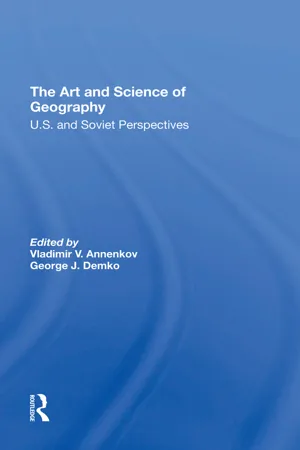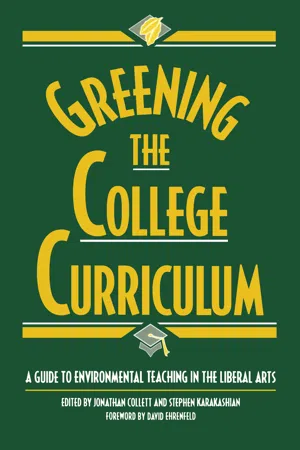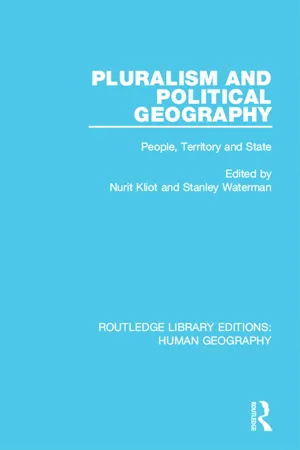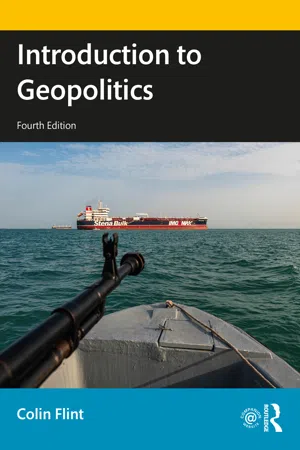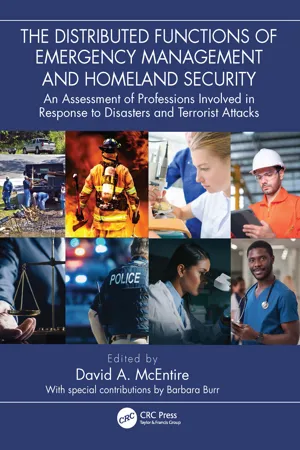Geography
Role of Government
The role of government in geography refers to the actions and policies implemented by a government to manage and regulate the use of natural resources, protect the environment, and promote sustainable development. This includes creating laws and regulations, providing funding for research and conservation efforts, and collaborating with other countries to address global environmental issues.
Written by Perlego with AI-assistance
Related key terms
6 Key excerpts on "Role of Government"
- eBook - ePub
The Art And Science Of Geography
U.s. And Soviet Perspectives
- Vladimir V. Annenkov, George J Demko(Authors)
- 2019(Publication Date)
- Routledge(Publisher)
Political geographers help many agencies understand today's changing world in the areas of boundary change, terrorism, refugee flows, and in keeping the federal government up-to-date on geographical information throughout the world. The U.S. Geological Survey is involved with mapping programs of every kind; economic geographers advise on the changing location of agricultural and industrial patterns; urban geographers consult on housing, transportation, and policy - development programs of all kinds. Research programs of the National Academy of Sciences and National Science Foundation are also influenced by geographers. Many of the same activities go on in the business world, where geographers play a major role in business location decisions. Willmott (USA): Geographers provide advice to industry about where to locate, to government on boundary disputes. They provide a wide range of information to many on cultural practices that favor or preclude the sale of certain products, available solar energy, air pollution sources and concentrations, weather patterns and health, leaching of toxic materials through land fills, climate information for travel agents, advice on the impacts of land use, market-region descriptions analysis, and many other areas. Morrill (USA): Knowledge and advice of geographers is given to business and government. I've devoted much of my professional life to this endeavor. Essentially, we need to inform about the options for and the consequences of environmental and locational decisions. All individuals, groups, enterprises, and governments make countless location and movement decisions. If we understand these processes, we should be of great assistance - No longer available |Learn more
- Meredith Marsh, Peter S. Alagona(Authors)
- 2023(Publication Date)
- Barrons Educational Services(Publisher)
theocracies, and they provide an excellent illustration of the impact of culture on politics. The second perspective flips this around and views political systems as the driving force behind different countries’ economic and cultural systems. In Kashmir, a region that lies on the border between India and Pakistan, many Muslims, who have more in common with their Pakistani neighbors, live on the Indian side of the border, while many Hindus, who have more in common with their Indian neighbors, live in Pakistan. The official border between these two countries, drawn by a political agreement in 1972, has been disputed for many years, and outbreaks of violence occur regularly in the region. This example shows how political structures can have important implications for culture. In recent years, political geographers contributed many important insights to the study of issues involving poverty, war, culture, ethnicity, and environmental change.STRATEGY
Some nations exist as communal identities without the benefit of an internationally recognized, cartographically defined state, such as the Palestinians, Kurds, and Quebecois. They are called “stateless nations.” Can you think of other examples? What are some problems associated with stateless nations?The Geography of Local and Regional Politics
Most political geographers focus their studies on one or more of the following geographic scales: local politics, national politics, and international politics. The country is the fundamental unit of political geography. A country, more formally called a state, may be composed of more than one nation. A nation consists of a group of people with a common political identity, but every nation does not have its own state. For example, Palestinians in the Middle East often consider themselves to be a stateless nation because they have been fighting to establish their own state for decades but have yet to achieve their goal. Israel, however, has achieved statehood designated by an internationally recognized government and territorial borders. The term nation-state - eBook - ePub
Greening the College Curriculum
A Guide To Environmental Teaching In The Liberal Arts
- Jonathan Collett, Stephen Karakashian, Jonathan Collett, Stephen Karakashian(Authors)
- 2013(Publication Date)
- Island Press(Publisher)
Conservation ideology is in transition. The conventional model—pre—serving nature in parks and reserves entirely isolated from human activities—has proven inadequate. Biologists now recognize that most parks and reserves are too small to support populations of large vertebrates, or to sustain ecological processes that generate and maintain high levels of biodiversity. Numerous case studies of parks in the tropics also prove that prohibiting all human use of protected areas is often socially infeasible. Conservationists have thus turned to a more holistic approach, where ecosystems are managed beyond the scale of a single park, and human resource use is incorporated in management strategies. This broad-scale, integrated approach requires an understanding of how humans adapt to and transform their biophysical environs. But how do we thoroughly evaluate environmental change on a large spatial and temporal scale? How do we distinguish land degradation from sustainable land use? These questions lie at the core of geographic inquiry. Geographers are well suited to explore the interface between local actions and global concerns. Geography leads students to examine the physical and social consequences of human interaction with the biosphere. Geography students also explore the evolution of environmental conservation as an ideology across time and culture. The goal of an introductory geography course is to prepare students to evaluate how they shape their local—as well as global—environment.Emphasis on Spatial Pattern and Focus on Human Agency in Shaping Landscapes
Geography is founded on an age-old intellectual tradition of observing human influence on the biophysical environment. During the past three centuries, as human capacity to alter the environment has escalated in scale, rate, and intensity, geographers have chronicled human degradation of physical habitats (Turner et al. 1992). At the turn of the 18th century, Alexander von Humboldt documented human influence on vegetation in his exploration of remote Andean regions. Sauer (1956, p. 49) later noted the ever-expanding role of humans as “ecologic dominants.” This school of thought persists in geography, characterized by the view that pristine or “untouched” ecosystems are, by and large, nonexistent (Denevan 1992). (See Chapter 2, Anthropology, for further discussion of this perspective.)The approach of geographers to the study of environmental change emphasizes spatial pattern, a large scale of inquiry (over space and time), and the integration of social and natural sciences. Geographers typically conduct research at the level of landscape or region; for example, considering land use patterns and their impact on vegetation in a drainage basin or watershed. Recently, geographers have begun working at much broader scales. Such a study is under way in Mexico, where Liverman (1990) is investigating the capacity of small-scale farmers to cope with climatic change over several decades. Research elsewhere documents local adaptation in land management upon elevated exposure to storms, oil spills, flooding, and other forms of environmental risk (Kates and Burton 1986). - eBook - ePub
Pluralism and Political Geography
People, Territory and State
- Nurit Kliot, Stanley Waterman(Authors)
- 2015(Publication Date)
- Routledge(Publisher)
PART IV: PLURALISM — THE STATE AND THE WORLD Chapter 16 ON THE INSTRUMENTAL FUNCTION OF POLITICAL GEOGRAPHY Shalom Reichman INTRODUCTIONIn this paper, several basic functions that geographical space can fulfil in the realm of government actions are outlined, demonstrating the rationale of such functions on the grounds of either efficiency or equity criteria. In addition, some typical problems encountered in the course of the application of policies which have a significant spatial component are examined. The instrumental’ function of political geography is defined as the subject of scientific inquiry which examines the intentional use of space by government in the furtherance of its political goals. Though related to the ‘spatial theme’ in political geography (Kliot 1982), the instrumental approach differs from the main body of research in the field, viewing issues from the perspective of the political actor. As such, it is probably closer to the spirit of recent work in the geography of public finance (Bennett 1980: 28–32, 61–72; Johnston 1980).That space can be used for the attainment of political objectives is as old as history (Gottmann 1966). There may be, however, considerable variation in the potential contribution of geographical factors in achieving the basic objectives that usually underly state interventions. These are (a) the provision of security and order, (b) the stimulation of economic growth and well-being and (c) the guarantee of social justice.Thus, it has been long recognised that geography plays an important strategic role in the defence of a territory, illustrated by the fact that spatial concepts, such as heartland and rimland were rapidly assimilated into the terminology of political geography and related disciplines.The importance of geography as means to attain economic goals is probably less than that for security needs. The concept of rent, as noted by the early political economists, is a good example of a potential geographical effect. Adam Smith recognised this when he lauded the benefits that accrue from ‘breaking down the monopoly of the country’ by the provision of a transportation infrastructure (Smith 1937 edition). - eBook - ePub
- Colin Flint(Author)
- 2021(Publication Date)
- Routledge(Publisher)
By the end of the chapter you will not only have a better sense of the human geography perspective but also of how it can be used as a framework for understanding and explaining geopolitics. You should also come away with two important overarching ideas. The first is contestation: Geopolitics is a continual process of defining the meaning of places, regions, and territory in a politics of inclusion and exclusion (who does and does not “belong”). In other words, geography is always political and, in some instances, the politics is violent. The second idea is context: The political events that are reported in the media happen within different geographical and historical settings, which partially define what happens and what possibilities for peace and resolution exist.Geography and politics
Human geography may be defined as the systematic study of what makes places unique and the connections and interactions between places (Knox and Marston, 1998, p. 3). In this definition, human geographers are seen to focus upon the study of particular neighbourhoods, towns, cities, or countries (the meaning of place being broad here). Geographers are people who study the specifics of the world – not just where Pyongyang is, but what its characteristics are. “Characteristics” may include weather patterns, physical setting, the shape of a city, the pattern of housing, or the transport system. Political geographers are especially interested, amongst other things, in topics such as how the city of Pyongyang, for example, is organized to allow for political control in a totalitarian country.However, places (whether neighbourhoods or countries) are not viewed as isolated units that can only be understood through what happens within them. The first definition also highlights the need to understand places in relation to the rest of the world. Are they magnets of in-migration or sources of out-migration? Are investors of global capital seeking to put their money in a particular place, or are jobs being relocated to other parts of the world? Is a place a site for drug production, such as areas of Afghanistan, or the venue for illegal drug use, such as suburban areas of the United States or Europe? Understanding a place requires analyzing how its uniqueness is produced through a combination of physical, social, economic, and political attributes – and how those attributes are partially a product of connections to other places, near and far. - eBook - ePub
The Distributed Functions of Emergency Management and Homeland Security
An Assessment of Professions Involved in Response to Disasters and Terrorist Attacks
- David A. McEntire, David A. McEntire(Authors)
- 2023(Publication Date)
- CRC Press(Publisher)
Contributions Relating to the Space and Place of Hazards, Disasters, and Terrorist Attacks Laura Siebeneck, Elyse Zavar, and Rachel WolfeDOI: 10.4324/9781003350729-3Introduction
Geographers, land use managers, and members of allied fields assume important roles in hazard and emergency management. Geographers engage in hazard management by identifying and mitigating potential hazards that pose risk to a community. Furthermore, they participate in emergency management by coordinating resources and identifying responsibilities related to crises, including disasters. Geographers assume diverse roles within these two areas due in part to the diversity of the geographic discipline. This discipline encompasses a range of scholarship including the study of the inhabitants of Earth, how they move across the globe, and their relationships to each other; all of which inform how disasters are managed. As noted geographer Yi-Fu Tuan (1991 , p. 99) explained, “Geography is the study of earth as the home of people.” The field is often divided into three general branches of foci: physical, human, and environmental geography. Physical geographers study the physical features on Earth’s landscape and the processes associated with creating these landforms (Holt-Jensen, 2009 ). Subject topics within physical geography span such features as flora, fauna, soils, glaciers, rivers, oceans, weather, and climate. Human geographers focus on people and a myriad of social phenomena as represented by the subfields of social, cultural, political, historical, and economic geography. Some topics examined in this area include population, migration, trade, transportation, nationalism, state-building, and urban development. Environmental geographers integrate concepts and topics from both physical and human geography to examine interactions between physical and human systems (Holt-Jensen, 2009 ). Environmental geography is characterized by the management of resources (e.g., water, minerals, flora) or hazards (e.g., earthquake, flood, fire) (Burton et al., 1993
Index pages curate the most relevant extracts from our library of academic textbooks. They’ve been created using an in-house natural language model (NLM), each adding context and meaning to key research topics.
